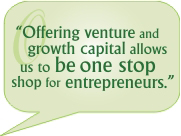Sequoia Capital India announced closing of its second Growth Equity fund at $725 million on Wednesday. This takes Sequoia Capital India’s total funds under management to a little under $1.8 billion. With the new fund, Sequoia plans to increase the ticket size of its investments and also plans to do more of late stage and PIPE deals. Sequoia India, which was formed after merging Westbridge Capital Partners with Silicon Valley based Sequoia in 2006, is one of the earliest and most active venture capital funds in India. Post the merger, Sequoia raised its first growth fund of $400 million in 2006. The firm has nearly finished investing out of this fund. Its investments from this fund include Idea Cellular, Edelweiss Capital, brokerage startup Unicon Financial, and garment retailer Cotton County. In a freewheeling interview with VC Circle’s Sahad PV, Sequoia Capital India Managing Director Sumir Chadha talks about the new fund and the investment environment in India. Excerpts:
You have just closed your second growth fund of $725 million. What will be the focus of the new growth fund?
In India, we run two sets of businesses- venture and growth equity. Both these business are managed by the same set of managing directors (five MDs include Sumir Chadha himself, KP Balaraj, Sandeep Singhal, SK Jain and the just promoted Abhay Pande) but we have dedicated teams for both of them. We opened an office in Mumbai an year and half ago to focus more on growth equity investments. With this new fund, we will have five funds in India. We are still investing in venture business out of Sequoia Capital III fund and we have nearly completely committed the first growth fund. Out of the first growth fund we have invested in companies like Café Coffee Day, Idea Cellular, Unicon Financial, Coastal Projects, Cotton County and so on. For growth equity we will focus on firms that are pretty large and profitable and are looking for expansion capital. We will also be looking to invest in SMEs. We think we can deploy this fund in next three years.
What will be the stage and sector focus of this fund? Will it be similar to the first fund?
 It will be late stage only and what that means is companies which have revenues of more than $50 million in topline. Companies should be making money and be profitable. In first growth fund, we focused on sectors such as financial services, retail, consumer services and infrastructure services to some extent. We will focus on the same sectors for the new fund too. We have been very opportunistic and if we see investment prospect in a new sector, we are always very flexible. The only major change from first fund will be that now we have a lot more capital to support entrepreneurs. So in Fund I, our typical investment size was $20-30 million, but in Fund II it will go more like $20-70 million.
It will be late stage only and what that means is companies which have revenues of more than $50 million in topline. Companies should be making money and be profitable. In first growth fund, we focused on sectors such as financial services, retail, consumer services and infrastructure services to some extent. We will focus on the same sectors for the new fund too. We have been very opportunistic and if we see investment prospect in a new sector, we are always very flexible. The only major change from first fund will be that now we have a lot more capital to support entrepreneurs. So in Fund I, our typical investment size was $20-30 million, but in Fund II it will go more like $20-70 million.
We are a very unique firm with presence in both venture and growth capital business. This makes us a one stop shop for entrepreneurs. For instance, when we met Vikram Akula from SKS Microfinance three years ago it was pretty early. We funded him with $6 million to help scale up the business. Last December, we led an internal round of $30 million. So the nice thing is that we keep investing in entrepreneurs and they don’t need to go outside.
Why do you think that this late stage investing model is good for India? Also Sequoia Capital has recently hired a hedge fund manager globally. Is this a global trend in which India has taken the lead?
This is a very unique (strategy) through which we are able to invest in entrepreneurs very early and also late stage. Other funds in India only just do one (either venture or private equity) and this model makes us a cut across in a meaningful way. Though Sequoia is known for its investments in companies like Google, Yahoo, Apple and Oracle when they were very small, it has been in growth capital investing in US for the last 15 years. We have been doing this in India and China for the last couple of years now. What we do differently from other guys is we don’t see ourselves as financial engineers. Early or late stage, what makes us unique we really try to help the companies scale. Also we are able to do a lot more value than just writing a cheque. We think of ourselves as active value adding shareholders, and entrepreneurs really like that because at the end of the day everybody’s money is green.
The world economy has started sputtering a little bit. Though for Sequoia it must have been pretty easy, what was the fund raising atmosphere like? Has there been any diversification of LPs?
I don’t mean to boast, but it’s a very short process for Sequoia. The reason for that is globally the performance has been very strong with fantastic 40 year track record in the US. Also India performance has been excellent, with six nice exits last year and lots of distributions going to the LPs. Three exits were through IPOs and in other four we sold our stake.
Coming to the LPs, we have not allowed many new ones expect a couple of small ones. What we find is Sequoia has a very consistent LP base of 60-70 investors who have been consistently investing with us for decades. All the top endowments and foundations in the US and a few select LPs from Singapore and Middle East we allow in, but it’s a very pristine partner base.
What were the three IPOs that you had last year?
 We had two IPOs from the growth fund. One was Idea Cellular, where we had invested $45 million and we got $90 million, which was across a 15 month period. Another one Edelweiss, in which had invested a small amount of $15 million. Though the markets have corrected 30-40% since we had invested in them nine months ago, we are still in the money in them. The third IPO was Firstsource Solutions, in which we sold about half our stake in beginning of last year.
We had two IPOs from the growth fund. One was Idea Cellular, where we had invested $45 million and we got $90 million, which was across a 15 month period. Another one Edelweiss, in which had invested a small amount of $15 million. Though the markets have corrected 30-40% since we had invested in them nine months ago, we are still in the money in them. The third IPO was Firstsource Solutions, in which we sold about half our stake in beginning of last year.
What about the other four strategic exits? Are there any other exits that you are looking at?
marketRx was sold to Cognizant for around $150 million. Then Zavata was sold for $160 million to Healthtree. Then we also sold our stake in BrainVisa to one of our companies Indecomm for a 3x multiple.
Even though the markets look tough, we have very healthy pipeline of IPOs coming up. We have 6-8 companies that could go public over the next 12-18 months and that is very exciting for us. Also we have companies in which we invested out of our first two venture funds - Applabs, Indecomm and GloabalLogic. We control 25-50% in these companies for small amounts and now their revenues are exceeding $100 million.
Which of these would you term as your multi-bagger exit?
From all these exits we have distributed to the LPs close to $250 million. We have had several multi-bagggers. In Firstsource and marketRx, we made 6-7 times of our money,
A bunch of deals are in the 5-10x range. Others were in the 2-5x range, but those were in the shorter time period. But I think better stuff is still to come.
How do you see the investment scenario and deal flow in India now? Do you think there are lots of good companies up for grabs?
I think there are lots of good companies in India and I am a great believer in the Indian entrepreneurs. But I think the valuations today are high for private companies in India. Particularly the late stage markets have not corrected. The best companies are not raising money yet, because they are profitable and have cash on their balance sheets. There is still too much money and too much optimism in the market. I think if the markets stay down for the next 6-7 months, then they will be forced to raise funds from outside.
Also we didn’t need to make a lot of deals. Even in the upmarket, we are able to find good companies and invest in them. There are always good companies and it’s a big economy.
Are you a believer in PIPE (Private Investment In Public Equity) deals? Will you be looking at PIPE deals?
 We are one of the few growth equity firms in India that did not do PIPE deals last year. If you look at the portfolios of private equity funds who did PIPE deals, they are down 40-60%. We had a term sheet out on one PIPE deal, but we got outbid. On the hindsight, we are glad that we did not do that deal.
We are one of the few growth equity firms in India that did not do PIPE deals last year. If you look at the portfolios of private equity funds who did PIPE deals, they are down 40-60%. We had a term sheet out on one PIPE deal, but we got outbid. On the hindsight, we are glad that we did not do that deal.
In the current market conditions, PIPE deals make more sense and we are definitely looking to do a few deals. For us, it’s a question of valuation and in a bull market we are surprised why anybody would do them. We would be looking at companies that are public, especially small public companies who are in high growth markets. These kind of companies would be of interest to us where we can take a substantial stake, add value and play a role in their growth process.
Growth Equity investment is a very competitive space and we see a lot of funds chasing the same deal. Investment bankers also show the same deal to a host of funds. How do you get around that?
I think there is a lot of competition in the growth space, more than the venture business. But most of our deals are non-banker deals. About 70% of the deals were proprietary deals, where we spotted the companies before any banker did. Like in Café Coffee Day deal, no banker was involved.
Also we differentiate ourselves by adding a lot of value. Like, for instance, in the case of Noida-based GlobalLogic, we have consigned six Sequoia backed co as clients and help them set up development centre in Beijing with help of Sequoia China partners. With Firstsource, we helped them hire their head of sales in US, because they didn’t have a good US network. With SKS Microfinance, we led the search for a CFO, who was appointed six months ago.
Also when we are making an investment, we ask the entrepreneurs to call any of portfolio companies CEOs and find out what they think about us. This is our best sales pitch in a competitive market.
Is Sequoia Capital India planning to expand the team?
 We have recently promoted Abhay Pandey to Managing Director. (They are now five managing directors managing five funds). We are a total of 15 people right now which include a few analysts we have hired from McKinsey. We would be looking to add one more operating partner. An operating partner for us means someone who has a deep domain expertise, who have built large companies. Currently we have Naresh Malhotra, who was the CEO of Café Coffee Day, and one who has domain expertise in retail. Mohit Bhatnagar, who was with Bharti Airtel, has expertise in mobile VAS and wireless. R Ramraj, who was the CEO of Sify, has expertise in internet segment. So they bring in-house operating expertise that is very crucial and give us an edge.
We have recently promoted Abhay Pandey to Managing Director. (They are now five managing directors managing five funds). We are a total of 15 people right now which include a few analysts we have hired from McKinsey. We would be looking to add one more operating partner. An operating partner for us means someone who has a deep domain expertise, who have built large companies. Currently we have Naresh Malhotra, who was the CEO of Café Coffee Day, and one who has domain expertise in retail. Mohit Bhatnagar, who was with Bharti Airtel, has expertise in mobile VAS and wireless. R Ramraj, who was the CEO of Sify, has expertise in internet segment. So they bring in-house operating expertise that is very crucial and give us an edge.
Where do you see opportunities to invest in?
I don't think there will be much change from the first fund. We will continue to look at retail, consumer and financial services, infrastructure services to some extent. Those are sectors in which we invested in from Fund I and we will keep investing. For venture fund, its different. That said, we will always remain very opportunistic and be open minded to invest in interesting companies in sectors we haven't spent much time on.
Since you are based out of US, how often do you travel to India? Are you planning to shift to India sometime soon?
I am here in India every six weeks or so. Earlier I used to spend a lot of time in Bangalore, but now its mainly Mumbai and Delhi since most of our portfolio companies are based out of there. We have a lot companies based out of Gurgaon and Noida. Overtime, we may look at an office in Delhi, but not immediately because as a small firm we don't want to be in too many offices. Even Mumbai office, which was opened one and a half years ago is now beginning to settle down nicely.
I am planning to shift to India next year, because the travel schedule over the last eight months has been pretty brutal.
(With Madhav A Chanchani)